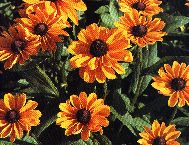Categories
Calendars
Guides
Reviews
Archive
Gallery
Articles
Ask Our Gardening Expert
Rudbeckia hirta plant care and growing
|
RUDBECKIA Plant profile |
|
Rudbeckia (or Coneflower or Black-eyed Susan) Rudbeckia originate from North America, this is why they like the sun in summer, but are
very hardy - North America has freezing winters, but gloriously
warm summers. Both annual and perennial varieties are readily available. The
reason for being nicknamed 'coneflower' is the black cone which is in the centre of
their flowers. Use them as border plants, or in pots. They come into flower
around the end of July, with medium sized golden yellow blooms, and will last
well past most other plants, right up to early November. They are excellent as cut flowers for
flower arrangements in the house. GardenAction have grown quite a few varieties of Rudbeckia, and it is best to know that most of them grow about 20% taller and wider than described on the seed packets, so be careful that you space them a little further apart than recommended. The only one we know which grows to height described on the seed packets is 'Marmalade' - a good variety, but not one of our recommended varieties because the seed germination rate is only about 40%. Cultivation
Cultivation
'for beginners guide' (5 easy, 1hard) Propagation Propagation
'for beginners guide' (5 easy, 1hard) Overall
Overall
'for beginners guide' (5 best, 1worst)
CLICK HERE FOR MORE ON RUDBECKIA |
Name: marie
E-mail: mariev88@optonline.net
Date posted: June 09, 2011 - 07:43 am
Message: some buggers are attacking my 3 yr old plants which look healthy enough but the leaves show damage. Please advise what I should do to stop the damage, lady bugs?

